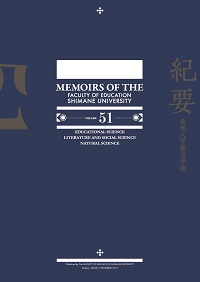島根大学教育学部
ISSN:2433-5355(オンライン)
ISSN:1880-8581(冊子体)
なお、冊子体の刊行は50号まで
ISSN:1880-8581(冊子体)
なお、冊子体の刊行は50号まで

ダウンロード数 : ? 件
この文献の参照には次のURLをご利用ください : https://ir.lib.shimane-u.ac.jp/6519
島根大学教育学部紀要 41
2007-12-25 発行
松江層玄武岩類の記載岩石学的研究
Petrological characteristics of Matsue basalt from the Matsue formation, Shimane Prefecture, southwest Japan
ファイル
内容記述(抄録等)
Matsue basalt formed by the mainly alkaline basaltic volcanic activity of the Miocene, located in the central part of Matsue city, Shimane prefecture, southwest Japan. Matsue basalt can be classified into the six groups of lava bodies shown below by field survey and texture and mineral assemblage on the microscope. There are Chausuyama basalt, Hanamagari basalt, Agenogi basalt, Tsuda basaltic andesite, Tohkodai andesite and Rakuzan basaltic andesite bodies. And Matsue basalt became clear that the five rock types exists in Petrology (mineral assemblage). That is three basalts (Chausuyama, Hanamagari and Agenogi basalts), one basaltic andesite (Tsuda and Rakuzan) and one andesite (Tohkodai andesite).That is Tsuda and Rakuzan basaltic andesites have the same petrological character. Futhermore, chromian spinel was found out from Chausuyama and Agenogi basalts.
Other Article
